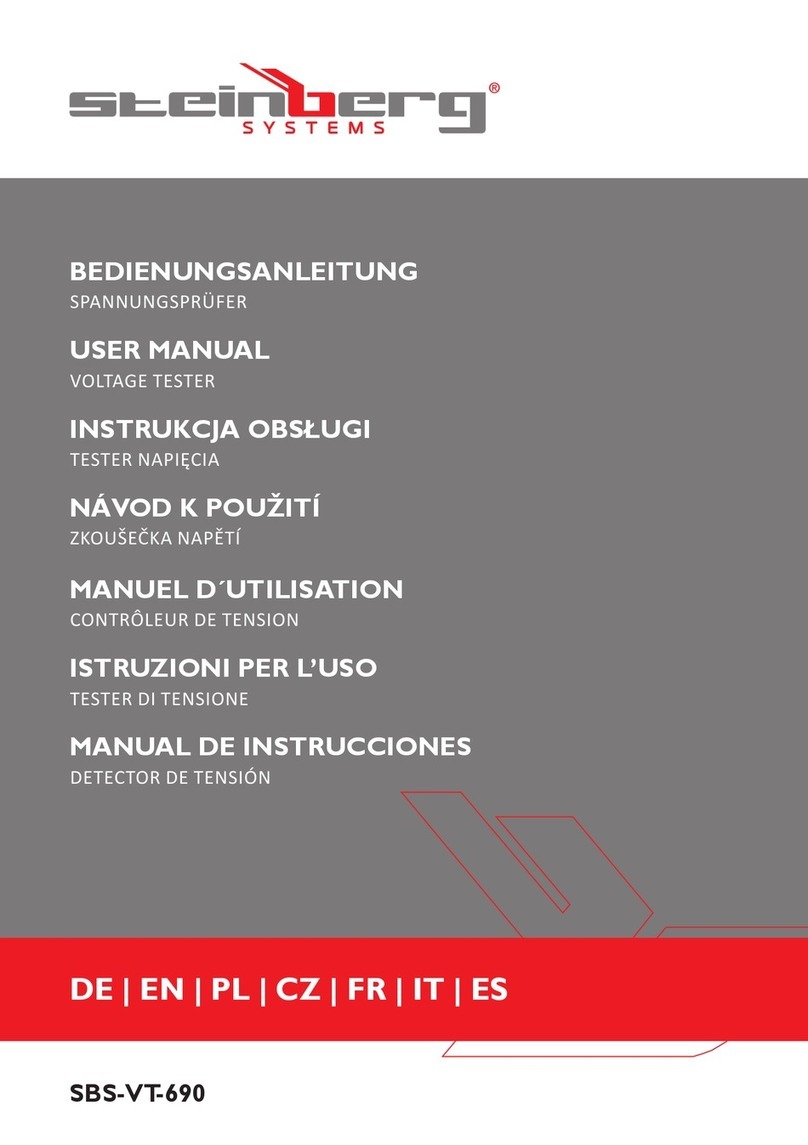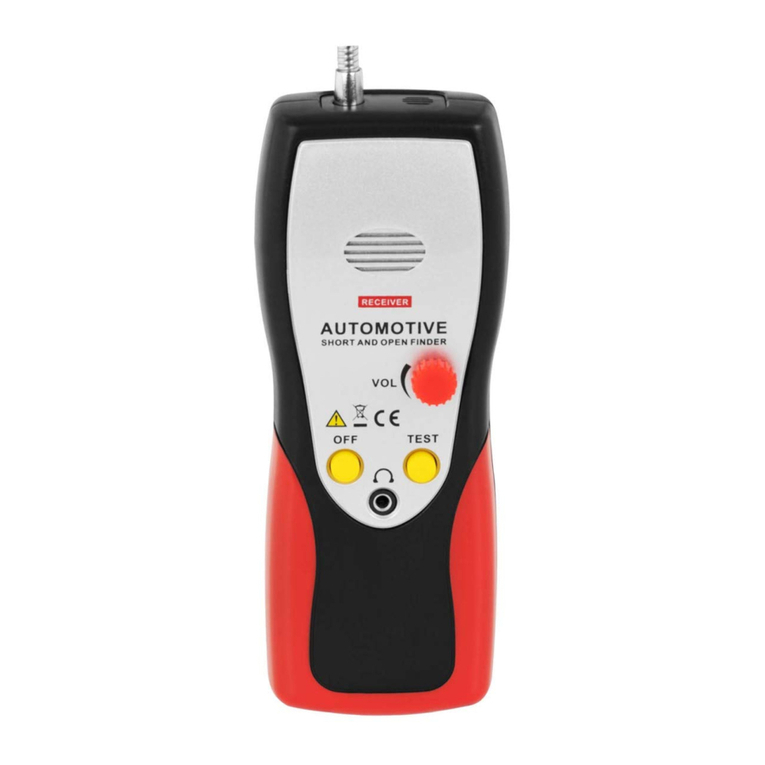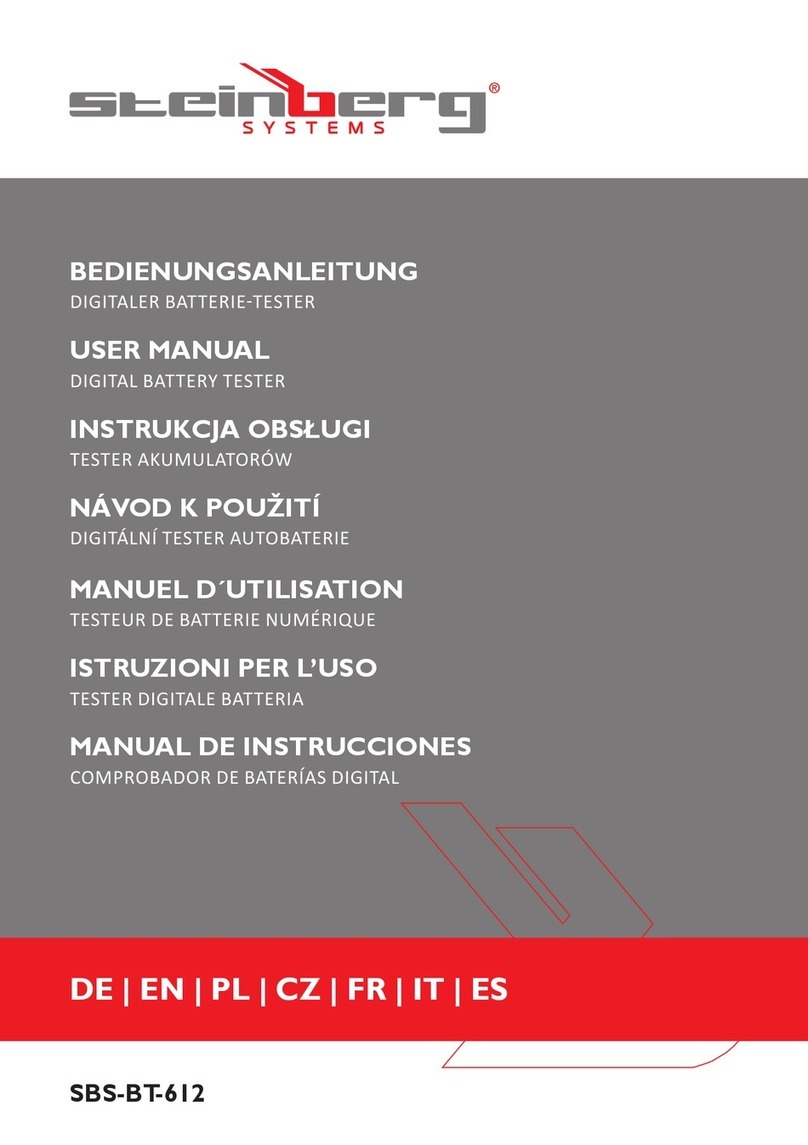
14 15
Rev. 23.01.2020
Rev. 23.01.2020
UWAGA! Ostrzeżenie przed porażeniem prądem
elektrycznym!
Założyć okulary ochronne.
Stosować rękawice ochronne.
UWAGA! Niebezpieczeństwo pożaru - materiały
łatwopalne!
Uwaga! Gorąca powierzchnia może
spowodować oparzenia!
Do użytku tylko wewnątrz pomieszczeń.
DANE TECHNICZNE
INSTRUKCJA OBSŁUGI
1. OGÓLNY OPIS
Instrukcja przeznaczona jest do pomocy w bezpiecznym
i niezawodnym użytkowaniu. Produkt jest zaprojektowany
i wykonany ściśle według wskazań technicznych przy
użyciu najnowszych technologii i komponentów oraz przy
zachowaniu najwyższych standardów jakości.
PRZED PRZYSTĄPIENIEM DO PRACY NALEŻY
DOKŁADNIE PRZECZYTAĆ I ZROZUMIEĆ NINIEJSZĄ
INSTRUKCJĘ.
Dla zapewnienia długiej i niezawodnej pracy urządzenia
należy dbać o jego prawidłową obsługę oraz konserwację
zgodnie ze wskazówkami zawartymi w tej instrukcji. Dane
techniczne i specykacje zawarte w tej instrukcji obsługi są
aktualne. Producent zastrzega sobie prawo dokonywania
zmian związanych z podwyższeniem jakości.
OBJAŚNIENIE SYMBOLI
UWAGA! Przeczytaj wszystkie ostrzeżenia
dotyczące bezpieczeństwa oraz wszystkie instrukcje.
Niezastosowanie się do ostrzeżeń i instrukcji może
spowodować porażenie prądem, pożar i/lub ciężkie
obrażenia ciała lub śmierć.
Termin „urządzenie” lub „produkt” w ostrzeżeniach i w opisie
instrukcji odnosi się do TESTER AKUMULATORÓW. Nie
należy używać urządzenia w pomieszczeniach o bardzo
dużej wilgotności / w bezpośrednim pobliżu zbiorników
z wodą! Nie wolno dopuszczać do zamoczenia urządzenia.
Ryzyko porażenia prądem! Nie wolno zasłaniać otworów
wentylacyjnych urządzenia!
2.1. BEZPIECZEŃSTWO ELEKTRYCZNE
a) Nie wolno dotykać urządzenia mokrymi lub
wilgotnymi rękoma.
b) UWAGA – ZAGROŻENIE ŻYCIA! Podczas czyszczenia
lub użytkowania urządzenia nigdy nie wolno
zanurzać go w wodzie lub innych cieczach.
2.2. BEZPIECZEŃSTWO W MIEJSCU PRACY
a) Utrzymywać porządek w miejscu pracy i dobre
oświetlenie. Nieporządek lub złe oświetlenie może
prowadzić do wypadków. Należy być przewidującym,
obserwować co się robi i zachowywać rozsądek
podczas używania urządzenia.
b) Nie używać urządzenia w stree zagrożenia
wybuchem, na przykład w obecności łatwopalnych
cieczy, gazów lub pyłów. Urządzenie wytwarzają
iskry, mogące zapalić pył lub opary.
c) W razie wątpliwości czy produkt działa poprawnie
lub stwierdzenia uszkodzenia należy skontaktować
się z serwisem producenta.
d) Naprawę produktu może wykonać wyłącznie
serwis producenta. Nie wolno dokonywać napraw
samodzielnie!
e) W przypadku zaprószenia ognia lub pożaru, do
gaszenia urządzenia pod napięciem należy używać
wyłącznie gaśnic proszkowych lub śniegowych (CO2).
f) Na stanowisku pracy nie mogą przebywać dzieci
ani osoby nieupoważnione. (Nieuwaga może
spowodować utratę kontroli nad urządzeniem.)
g) Urządzenie używać w dobrze wentylowanej
przestrzeni.
h) Należy regularnie sprawdzać stan naklejek
z informacjami dotyczącymi bezpieczeństwa.
2. BEZPIECZEŃSTWO UŻYTKOWANIA
Produkt spełnia wymagania odpowiednich norm
bezpieczeństwa.
Przed użyciem należy zapoznać się z instrukcją
Produkt podlegający recyklingowi.
UWAGA! lub OSTRZEŻENIE! lub PAMIĘTAJ!
opisująca daną sytuacje (ogólny znak
ostrzegawczy).
Instrukcją oryginalną jest niemiecka wersja instrukcji.
Pozostałe wersje językowe są tłumaczeniami z języka
niemieckiego.
UWAGA! Ilustracje w niniejszej instrukcji obsługi
mają charakter poglądowy i w niektórych szczegółach
mogą różnić się od rzeczywistego wyglądu produktu.
Nazwa produktu Tester Akumulatorów
Model SBS-BT-612
Klasa ochronności III
Klasa ochrony IP IP 40
Wymiary [mm] 210 x 120 x 73
Ciężar [kg] 0,78
Typ obsługiwanych
akumulatorów Ołowiowo-kwasowe,
6/12 V
Zakres testu prądu ładowania
[A] <80
Zakres testu pojemności
akumulatora [Ah] 40 – 200
Maksymalna wartośc napięcia
dla prądu stałego [V] 19,99
Test wewnętrznego oporu
akumulatora (mΩ) 1,00 – 99,99
Zakres pojemności
obsługiwanego akumulatora
[Ah] 40 – 200 (skok co 5)
Test rozruchowy Dla akumulatorów 12V
Obsługiwane standardy
zakresu akumulatorów [A]
CCA 100 ~ 1700
IEC 100 ~ 1000
EN 100 ~ 1700
DIN 100 ~ 1000
Zakres temperatury pracy [°C] -10 – +40
Czas/interwał testu Ok. 10 s / co 5 min.
PAMIĘTAJ! Należy chronić dzieci i inne osoby
postronne podczas pracy urządzeniem.
2.3. BEZPIECZEŃSTWO OSOBISTE
a) Niedozwolone jest obsługiwanie urządzenia w stanie
zmęczenia, choroby, pod wpływem alkoholu,
narkotyków lub leków, które ograniczają w istotnym
stopniu zdolności obsługi urządzenia.
b) Urządzenie mogą obsługiwać osoby sprawne
zycznie, zdolne do jego obsługi i odpowiednio
wyszkolone, które zapoznały się z niniejszą instrukcją
oraz zostały przeszkolone w zakresie bezpieczeństwa
i higieny pracy.
c) Urządzenie nie jest zabawką. Dzieci powinny być
pilnowane, aby nie bawiły się urządzeniem.
2.4. BEZPIECZNE STOSOWANIE URZĄDZENIA
a) Nie należy przeciążać urządzenia. Używać narzędzi
odpowiednich do danego zastosowania. Prawidłowo
dobrane urządzenie wykona lepiej i bezpieczniej
pracę dla którego zostało zaprojektowane.
b) Przed przystąpieniem do regulacji, czyszczenia
i konserwacji urządzenie należy odłączyć od
zasilania. Taki środek zapobiegawczy zmniejsza
ryzyko przypadkowego uruchomienia.
c) Nieużywane urządzenia należy przechowywać
w miejscu niedostępnym dla dzieci oraz osób
nieznających urządzenia lub tej instrukcji
obsługi. Urządzenia są niebezpieczne w rękach
niedoświadczonych użytkowników.
d) Utrzymywać urządzenie w dobrym stanie
technicznym. Sprawdzać przed każdą pracą czy
nie posiada uszkodzeń ogólnych lub związanych
z elementami ruchomymi (pęknięcia części
i elementów lub wszelkie inne warunki, które mogą
mieć wpływ na bezpieczne działanie urządzenia).
W przypadku uszkodzenia, oddać urządzenie do
naprawy przed użyciem.
e) Urządzenie należy chronić przed dziećmi.
f) Naprawa oraz konserwacja urządzeń powinna być
wykonywana przez wykwalikowane osoby przy
użyciu wyłącznie oryginalnych części zamiennych.
Zapewni to bezpieczeństwo użytkowania.
g) Aby zapewnić zaprojektowaną integralność
operacyjną urządzenia, nie należy usuwać
zainstalowanych fabrycznie osłon lub odkręcać śrub.
h) Nie należy pozostawiać włączonego urządzenia bez
nadzoru.
i) Należy regularnie czyścić urządzenie, aby nie
dopuścić do trwałego osadzenia się zanieczyszczeń.
j) Nie wolno zasłaniać wlotu i wylotu powietrza.
k) Urządzenie nie jest zabawką. Czyszczenie
i konserwacja nie mogą być wykonywane przez
dzieci bez nadzoru osoby dorosłej.
PAMIĘTAJ! Pomimo iż urządzenie zostało
zaprojektowane tak aby było bezpieczne, posiadało
odpowiednie środki ochrony oraz pomimo użycia
dodatkowych elementów zabezpieczających
użytkownika, nadal istnieje niewielkie ryzyko wypadku
lub odniesienia obrażeń w trakcie pracy z urządzeniem.
Zaleca się zachowanie ostrożności i rozsądku podczas
jego użytkowania.
3. ZASADY UŻYTKOWANIA
Urządzenie przeznaczone jest do:
• testowania stanu akumulatorów ołowiowo-
kwasowych 6/12 V;
• testowania stanu alternatorów w pojazdach.
Odpowiedzialność za wszelkie szkody powstałe w wyniku
użytkowania niezgodnego z przeznaczeniem ponosi
użytkownik.
3.1. OPIS URZĄDZENIA
Urządzenie wyposażenie jest w zabezpieczenie przed:
• słabym kontaktem zacisków biegunowych,
• pomyleniem biegunów,
• zbyt wysokim napięciem.
W przypadku gdy, naklejki są nieczytelne należy je
wymienić.
i) Zachować instrukcję użytkowania w celu jej
późniejszego użycia. W razie, gdyby urządzenie miało
zostać przekazane osobom trzecim, to wraz z nim
należy przekazać również instrukcję użytkowania.
j) Elementy opakowania oraz drobne elementy
montażowe należy przechowywać w miejscu
niedostępnym dla dzieci.
k) Urządzenie trzymać z dala od dzieci i zwierząt.
l) W trakcie użytkowania tego urządzenia wraz z innymi
urządzeniami należy zastosować się również do
pozostałych instrukcji użytkowania.
1 5
4
2
3
1. Kratka wentylacyjna
2. Wyświetlacz
3. Panel przycisków sterowania
• v ^ - nawigacja w menu
• ESC – wyjdź/cofnij
• ENTER – zatwierdź/wybierz
4. Kontrolki stanu akumulatora:
• Zielona (GOOD) – akumulator sprawny
• Żółta (WEAK) – akumulator słaby (do naładowania)
• Czerwona (BAD) – akumulator rozładowany
5. Zaciski na bieguny akumulatora/klemy (czerwony +,
czarny -)
3.2. PRZYGOTOWANIE DO PRACY
UMIEJSCOWIENIE URZĄDZENIA
Temperatura otoczenia nie może przekraczać 40°C
a wilgotność względna nie powinna przekraczać 85%.
PLPL
l) Zabrania się ingerowania w konstrukcję urządzenia
celem zmiany jego parametrów lub budowy.
m) Trzymać urządzenia z dala od źródeł ognia i ciepła.
n) Nie należy przeciążać urządzenia.
o) Unikać kontaktu metalowych przyrządów z biegunami
akumulatora lub klemami urządzenia podłączonego
do niego – ryzyko zwarcia i uszkodzenia instalacji
elektrycznej.
































